This condensed history was compiled by Phil Holmes.
The modern city of Fremont has been built on beautiful land with a long, interesting history. This rich, historical heritage fits readily into time periods that had their own specific influences on the history of Fremont.
The Ohlone People
Ancestors of the Ohlone people wandered into this land of great abundance several thousand years ago. They lived a simple life in harmony with nature and the land. They followed the cycles of the seasons as they hunted, fished, and gathered their food. They burned certain areas to encourage the growth of favored plants and improve grazing areas for animals that they hunted.
The Ohlones gathered a variety of plants, seeds, berries, roots, and nuts for food. They ground and leached acorns and made mush or bread. They caught rabbits, squirrels, birds, fish, and other small animals and gathered shellfish from the bay. Hunters stalked larger animals such as deer and antelope.
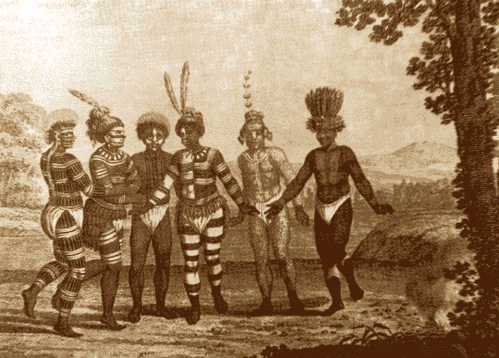
Ohlone Indian Ceremonial Dance at Mission San Jose in 1806.
Permanent villages were located on higher ground near marshes, streams, or springs where drinking water was available. They built domed huts with a frame of poles thatched with grass or tules. They crafted baskets, clothes, decorations, tools, nets, beads, and weapons. They navigated the bay in remarkable reed boats and traded materials or products with other tribes.
Religion and ceremony were important in daily life activities, and special rituals were observed at important events such as birth, puberty, and death. The Ohlones maintained their culture by passing on stories, songs, dances, and tribal laws from parents to children. The Ohlone way of life minimized warfare and ensured the health of the land. Life was ordered and in tune with nature and the will of the creator.
Mission San Jose 1797-1836
Mission San Jose was founded by Father Fermin Lasuen June 11, 1797. It was the 14th California Mission and was located about 15 miles northeast of the Pueblo of San Jose near the foot of Mission Peak. Temporary thatched roof structures were erected until more permanent adobe buildings could be erected.
The Ohlone way of life was changed forever. The Franciscan Fathers began converting the Ohlones to Catholicism and changing them into farmers, herders, laborers, and craftsmen. Hundreds of them came to live and work at the Mission which became the center of their religious, education, social, and economic lives. Under the Padres directions they learned to make clothes, shoes, utensils, tools, ropes, and candles. They cared for the animals, raised crops, erected adobe buildings, and eventually even constructed a big church. Mission San Jose baptized more Indians than any other mission and reached a peak population of 1,900. Disease and change of lifestyle killed many and decreased their number. Some Ohlone people did not want to live at the Mission, but their old way of life quickly disappeared.
The site was blessed with wonderful natural resources. Under the resourceful direction of dedicated Padres, Mission San Jose thrived and grew until it became the most prosperous and successful mission in Northern California. Its vast herds of cattle, horses, mules, and sheep roamed the East Bay and the valleys and hills far to the east. It furnished much of the food for other missions and government entities. Many foreigners came to visit and trade for Mission products.

Mission San Jose, the first known photographic image, by C.E. Watkins, 1853
Father Narciso directed the Mission from 1806 to 1833. Under his leadership the adobe church was completed in 1809 and the Mission gained recognition for its music and choir.
Mission San Jose survives today as a reminder of our Spanish heritage and a memorial to the thousands of Native Americans who lived, worked, and died here. This is where the first Christian Church, school, industry, farming, and cattle raising in Alameda County began. The adobe museum building is a surviving remnant of the huge original rectangle of living quarters, shops, and storerooms. A replica of the 1809 adobe church was completed in 1984.
The Rancho Era 1836-1848
Mexico won independence from Spain and began to reward soldiers and prominent citizens with huge grants of land known as ranchos. This process of secularization gradually brought an end to the Mission Era and ushered in the Rancho Era. Governor Juan Alvarado appointed his friend, Jose de Jesus Vallejo, administrator of the secularized Mission San Jose in 1836. He arrived with orders to distribute the Mission property.
Our area was carved into four large tracts: Rancho del Agua Caliente (Warm Springs area), Rancho Arroyo de la Alameda (Niles – Decoto area), Rancho Potrero de los Cerritos (Newark – Alvarado area). The land surrounded by these three grants was known as Ex-Mission San Jose (Mission San Jose – Irvington – Newark) and was granted by Governor Pico just before the Mexican War.
The rancheros ran vast herds of cattle that provided for their needs. Life revolved around the herds and was enlivened by fiestas and feasts. They were skilled horsemen and rode everywhere. They traded hides for things they could not grow or make. They were religious, gracious, healthy, family-oriented people who enjoyed their simple, vigorous, outdoor life.
The Mission system that had dominated the lives of the Ohlone people was replaced by the Mexican government. Many Ohlones went to work on the Mexican ranchos, but some returned to their former way of life or joined local Indian communities.
The peaceful, pastoral life of the ranchos began to change with the arrival of American settlers. The Brooklyn brought a group of Mormons to San Francisco in 1846. Some of them stayed and became prominent settlers in the East Bay. Colonel John C. Fremont came through, foraging and recruiting as he pursued the Mexican forces. He liked Mission San Jose so much he tried to buy it.
The treaty at the end of the War with Mexico made California part of the United States. The discovery of gold brought a horde of miners, businessmen, adventurers, speculators, and settlers from around the world in search of land, wealth, and a new life. They took over the Rancho lands, squeezed out the landowners, and ended the Rancho Era.
The Pioneer Era 1848-1860
American settlers migrated overland or came by ship to the San Francisco Bay area. They bought, rented, or just took over the fertile farm land in our area. Many squatters settled on the Ex-Mission San Jose grant because of confusion created by the doubtful title.
These American pioneers planted thousands of acres of grain and vegetables and changed the economy from peaceful pastoral to intensive agricultural (business, marketing, and industry). They took over the old Mission and rancho landings, built wharves and warehouses, and shipped their produce to San Francisco. John Horner farmed thousands of acres and was recognized as California’s first farmer. The East Bay became the leading agricultural area in California.
Mission San Jose became a boisterous supply center for hordes of miners on their way to the gold mines. Elias Beard, Henry Smith, and others opened stores, lodging quarters, restaurants, and saloons in the old adobe buildings. A post office was established here in 1850 before California became a state.
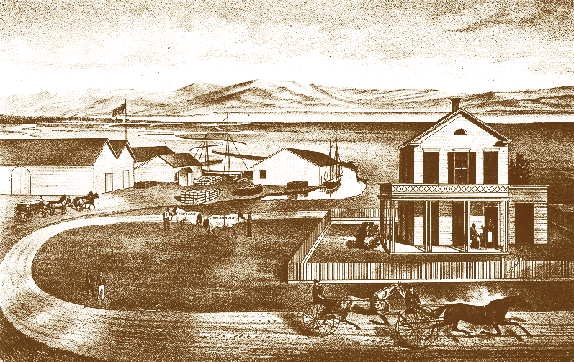
Warm Springs Landing
Henry Smith was elected to the California State Assembly and led the fight to create the new county of Alameda with the court house located in his store in his town on the bank of Alameda Creek. Pioneer Alameda County government was developed here at Alvarado. For a few years our area (which was named Washington Township) was the center for the political, social, and cultural activities of the county.
American pioneers built stores, schools, churches, and lodges. They developed industries, improved roads, provided transportation, and created a climate for business and development. Crops were good, business thrived, and money circulated in waves of prosperity until the panic of 1855 temporarily halted progress. Some pioneers lost almost everything in the panic, but they battled through the crisis and continued developing their farm and business enterprises. Farmers on Ex-Mission San Jose land finally obtained title to their land in 1867.
The Era of Towns 1860-1945
Eight towns developed in Washington Township. Mission San Jose was the center that led to the founding of the others. Alvarado was a shipping center and served as the county seat from 1853 to 1856. Several organizations that served the entire township were located in Centerville because of its central location. Irvington began as a saloon but became the site of our first college and an educational and cultural center. The Spanish called Warm Springs Agua Caliente (hot water). Americans made it a health spa and resort.
The railroads brought great changes to our area in the Seventies. The little hamlet of Vallejo Mills became a railroad junction that developed into the town of Niles. The Decoto Land Company was incorporated to buy land and lay out the town of Decoto along the Western Pacific Railroad line. The town of Newark was started by the South Pacific Coast Railroad which built a narrow gauge line south to Santa Cruz and north to Alameda. Newark became famous for the Carter rail cars manufactured there.
The railroads moved freight faster than was possible by wagon or ship. Ship landings disappeared and wagons carried freight to nearby rail stations. People were now able to commute to work in Oakland or San Francisco.
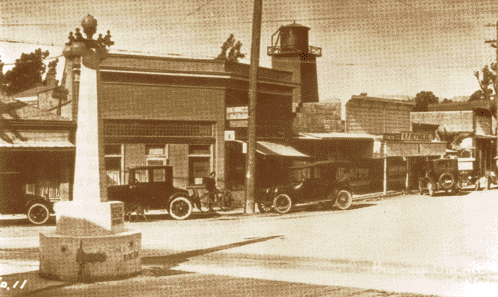
Irvington Business District circa 1920’s
Each town had its own stores, churches, schools, halls, post offices, and organizations. Each enjoyed periods of growth and suffered through floods, fires, and depressions. All survived the earthquakes of 1868 and 1906. Niles enjoyed a period of excitement from 1912 to 1916 when the Essanay Film Manufacturing Company made silent movies there. Bronco Billy, Charlie Chaplin, Ben Turpin, Evelyn Selbie, Wallace Beery, cowboys, Indians, and baseball players created an atmosphere of excitement and make believe.
Residents of Washington Township were united by geography and government but were separated into eight small towns. People visited freely and attended events throughout the township but retained a special loyalty to their own town. Organizations such as The Pioneer Society and some lodges and churches drew members from the entire township. Residents always joined forces to meet such dangers as floods, proposed legislation, and water shortage.
Building Union High School No. 2 at Centerville in 1892 became the greatest cultural, social, and economic force in the township. It was the hub of activities that joined people of all ages throughout the township. Students came from all eight towns to attend their high school. Generations of graduates went out to work in Washington Township with strong ties to their school. Many of the important events and meetings for the area were held at the high school. The musical, sports, and educational school programs drew people together and unified their efforts in a spirit of community service and improvement.
Orchards and vineyards replaced miles of grain fields. Disease wiped out most vineyards about 1900, and Prohibition devastated the wine industry. The water table dropped, crops had to be irrigated and a water shortage developed. Electricity was brought in to power industries, farms, and homes. Automobiles replaced buggies and wagons.
World War I interrupted life for many but was followed by a building boom in the Twenties. The stock market crash in 1929 threw the nation into a depression. Prices dropped, business slowed, unemployed workers went on relief, and farmers could not afford to sell their crops. The approach of World War II ended the depression and brought back development and economic prosperity.
Pearl Harbor changed everything for everybody. Many young men and women scattered around the world to fight the war. People of all ages worked in defense industries or on the farms. Life in Washington Township was filled with blackouts, Red Cross and defense programs, bond and scrap drives, price ceilings, restrictions, shortages, rationing, air raid signals, enlistments, draft calls, separations, and sad telegrams. All Japanese Americans were evacuated from the Township in May 1942. All development that was not part of the war effort was postponed.
Post War Era 1945-1996
Washington Township remained a peaceful paradise, unchanged by the dramatic postwar boom that transformed California into an industrial giant. Dairies, apricot orchards, and fields covered the land around the eight communities with a combined population of 25,000. There were three flood zones, eight fire districts, four sanitary districts, nine school districts, and Washington Township Hospital District, but basic government was controlled by the Alameda County Board of Supervisors in Oakland.
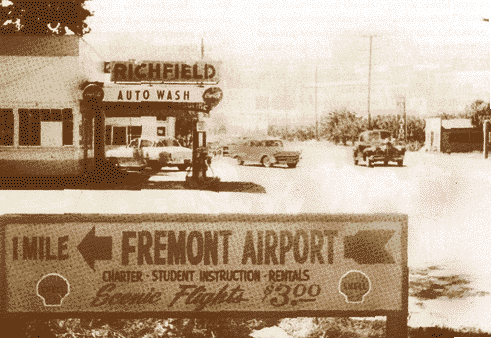
Service station and orchards at the corner of Fremont Boulevard and Mowry Avenue, 1956
The most amazing local events were associated with the growth of the area. Housing tracts were appearing in orchards and fields. Residents realized that growth was inevitable, but they were concerned that uncontrolled development would destroy their way of life. They did not want to be annexed by powerful neighbors. They wanted control and made some efforts to create one large city out of Washington Township.
Local chambers discussed problems of development, zoning, and incorporation. The central areas of Newark, Irvington, and Decoto received precise zoning by the county. The Washington Township Chamber of Commerce formed a committee to study incorporation. These studies led to the incorporation of Newark as a separate city in 1955.
The towns of Niles, Mission San Jose, Centerville, Irvington, and Warm Springs were incorporated into the City of Fremont in 1956. Some 22,000 people lived between Mission Peak and the bay. The size of the area and the melding of five towns into one city presented special problems. Planners located industry in the southern part and commercial development near the center. Conflicting factions sometimes polarized the city, especially during the campaign to locate city hall and establish a city center.
The opening of the Hub in 1962 was the first step in the development of the Central Business District. The General Motors plant opened in 1963.
The City of Fremont has gradually developed civic facilities and parks. Central Park was opened in 1962, the City Government Building in 1968, Lake Elizabeth in 1969, the Library Building in 1989 and the Police Building in 1996.
Bibliography of Local History
Most of these publications are available at the Fremont Main Library.
Bartels, Ronald Earl, “The Incorporation of the City of Fremont: an Experiment in Local Government.” Masters Thesis, University of California, Berkeley, CA, 1959.
Country Club of Washington Township, “History of Washington Township.” Stanford University Press, Sanford, CA, latest 1965 reprint.
DeRiemer, Thomas A., “Washington Township Incorporation Survey.” Coro Foundation, San Francisco, CA 1953.
Fremont Unified School District, “Pathways.” Fremont, CA, 1981
Halley, William, “The Centennial Yearbook of Alameda County.” Oakland, CA, 1876.
Holmes, Phillip, and Rose, Dolores, “Reflections, the Education Heritage of Fremont. “Fremont Unified School District, Fremont, CA, 1983.
Johnson, Paul C., “Pictorial History of California.” Bonanza Books, New York, NY, 1970.
Kern, Roy E., “The Vallejos of Mission San Jose.” Mission Peak Heritage Foundation, Fremont, CA, 1987.
Local History File. Clippings and pamphlets indexed by subject, Fremont Main Library.
Margolin, Malcom, “The Ohlone Way.” Heyday Books, Berkeley, CA, 1978.
McCarthy, Francis F., “The History of Mission San Jose.” Academy Library Guild, Fresno, CA, 1958 Bicentennial Edition published by Committee for the Restoration of Mission San Jose.
Mission Peak Heritage Foundation, “The City of Fremont: The First Thirty Years”, 1989.
Myers, Jenena, “The Incorporation of Fremont – 1956. A dedicated Civic Process Towards Home Rule.” Westernday, 1974.
Oral History Tapes. Mission Peak Heritage Foundation (Maurice Marks), Fremont, CA, at Ohlone College and Fremont Main Library.
Sandoval, John, “Chapel of Chimes”. A series of booklets in published in cooperation with the Hayward Historical Society.
Sandoval, John, “The History of Washington Township.” Mt. Eden Historical Publishers, 1985.
Shinn, Charles Howard, “Historical Sketches of Southern Alameda County.” Alameda County Historical Society, Oakland, CA, 1991.
Thompson, E. B., “Washington Press, Special Edition.” Irvington, 1898.
Thompson and West, “Historical Atlas of Alameda County, California.” Oakland, CA, 1978. Bicentennial Reprint by Mission Peak Heritage Foundation, Valley Publishers, Fresno, CA, 1976.
Williamson, Gladys. Clipping file in Fremont Main Library.
Wood, M. W., “History of Alameda County”. M. W. Wood Publisher, Oakland, CA, 1883. Reprints are available.
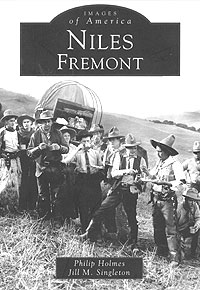 By Philip Holmes and Jill Singleton
By Philip Holmes and Jill Singleton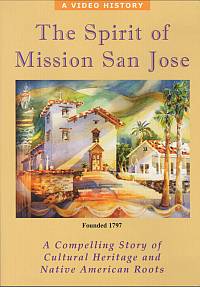 Travel back in time to discover the Stone Age lifestyle of the first inhabitants – the Ohlone Indians. Experience a typical day in the life at Mission San Jose. Hear in the settlers’ own words about grizzly bear encounters and other pioneer hardships. Visit the Unique districts the Mission spawned such as Centerville, Irvington, Niles, and Warm Springs. Meet colorful characters from the area’s rich past including Charlie Chaplin. Local history in the compelling story of this treasured landmark.
Travel back in time to discover the Stone Age lifestyle of the first inhabitants – the Ohlone Indians. Experience a typical day in the life at Mission San Jose. Hear in the settlers’ own words about grizzly bear encounters and other pioneer hardships. Visit the Unique districts the Mission spawned such as Centerville, Irvington, Niles, and Warm Springs. Meet colorful characters from the area’s rich past including Charlie Chaplin. Local history in the compelling story of this treasured landmark.



